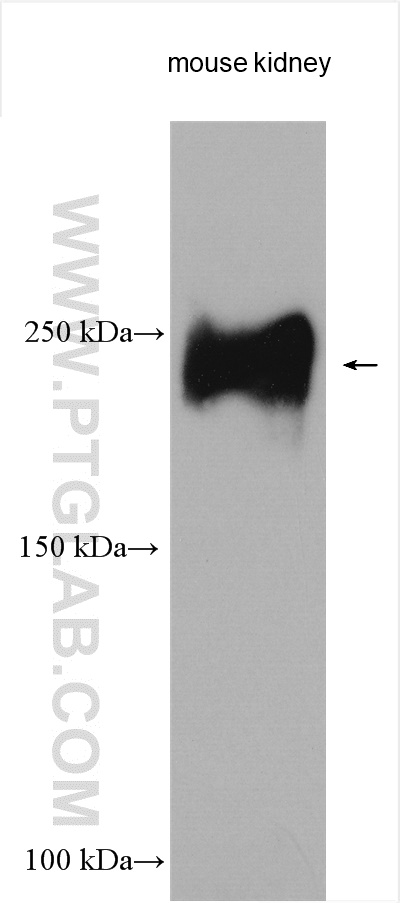验证数据展示
经过测试的应用
| Positive WB detected in | mouse kidney tissue |
推荐稀释比
| 应用 | 推荐稀释比 |
|---|---|
| Western Blot (WB) | WB : 1:600-1:2000 |
| It is recommended that this reagent should be titrated in each testing system to obtain optimal results. | |
| Sample-dependent, Check data in validation data gallery. | |
发表文章中的应用
| WB | See 1 publications below |
产品信息
28524-1-AP targets THSD7A in WB, ELISA applications and shows reactivity with Human, Mouse samples.
| 经测试应用 | WB, ELISA Application Description |
| 文献引用应用 | WB |
| 经测试反应性 | Human, Mouse |
| 文献引用反应性 | human |
| 免疫原 | THSD7A fusion protein Ag29107 种属同源性预测 |
| 宿主/亚型 | Rabbit / IgG |
| 抗体类别 | Polyclonal |
| 产品类型 | Antibody |
| 全称 | thrombospondin, type I, domain containing 7A |
| 别名 | KIAA0960, THSD7A |
| 计算分子量 | 185 kDa |
| 观测分子量 | 240-250 kDa |
| GenBank蛋白编号 | NM_015204 |
| 基因名称 | THSD7A |
| Gene ID (NCBI) | 221981 |
| RRID | AB_2918172 |
| 偶联类型 | Unconjugated |
| 形式 | Liquid |
| 纯化方式 | Antigen affinity purification |
| UNIPROT ID | Q9UPZ6 |
| 储存缓冲液 | PBS with 0.02% sodium azide and 50% glycerol, pH 7.3. |
| 储存条件 | Store at -20°C. Stable for one year after shipment. Aliquoting is unnecessary for -20oC storage. |
背景介绍
Thrombospondin type-1 domain-containing protein 7A (THSD7A) is a membrane-associated N-glycoprotein with a molecular weight of 250 kDa, which can be cleaved to release a 210-kDa soluble form (PMID: 22194972; 27214550). THSD7A has a role in angiogenesis. It mediates endothelial cell migration and tube formation (PMID: 2002048). THSD7A has been identified as a second autoantigen involved in adult idiopathic membranous nephropathy in addition to PLA2R1 (PMID: 25394321).
实验方案
| Product Specific Protocols | |
|---|---|
| WB protocol for THSD7A antibody 28524-1-AP | Download protocol |
| Standard Protocols | |
|---|---|
| Click here to view our Standard Protocols |
